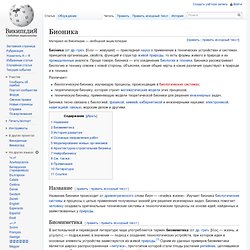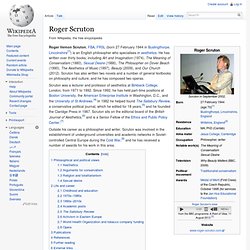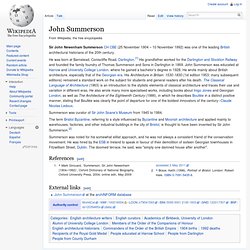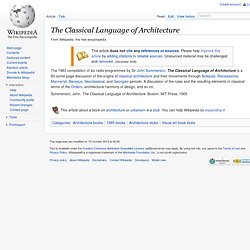

Бионика. Био́ника (от др.

-греч. βίον — живущее) — прикладная наука о применении в технических устройствах и системах принципов организации, свойств, функций и структур живой природы, то есть формы живого в природе и их промышленные аналоги. Проще говоря, бионика — это соединение биологии и техники. Бионика рассматривает биологию и технику совсем с новой стороны, объясняя, какие общие черты и какие различия существуют в природе и в технике. Различают: биологическую бионику, изучающую процессы, происходящие в биологических системах;теоретическую бионику, которая строит математические модели этих процессов;техническую бионику, применяющую модели теоретической бионики для решения инженерных задач.
Бионика тесно связана с биологией, физикой, химией, кибернетикой и инженерными науками: электроникой, навигацией, связью, морским делом и другими. Название[править | править исходный текст] Название бионики происходит от древнегреческого слова бион — «ячейка жизни». Известные испанские архитекторы М. Мимесис. Вильгельм Бендтц, «Скульптор Кристен Кристенсен лепит с натуры в своей студии», 1827 Ми́месис, или мимезис, (др.

-греч. μίμησις — подобие, воспроизведение, подражание) — один из основных принципов эстетики, в самом общем смысле — подражание искусства действительности. Античность[править | править исходный текст] Владислав Татаркевич выделяет четыре основных значения для греческого слова в классический период: первичное (обрядовое)подражание способу действия природы (Демокрит)простое копирование (Платон)творческое воспроизведение (Аристотель) Обряд[править | править исходный текст]
Ревзин Г.И. — Неоклассицизм в русской архитектуре начала XX века - 26 Апреля 2011 — Архитектурная Графика.
Architecture: celebrating the past ... Rethinking representation. Digital-semper2. Boring classics. Sollertiae-ae-rationis-pro-portione. Против ордера. Классика в современной архитектуре. Roger Scruton. Scruton was a lecturer and professor of aesthetics at Birkbeck College, London, from 1971 to 1992.

Since 1992, he has held part-time positions at Boston University, the American Enterprise Institute in Washington, D.C., and the University of St Andrews.[4] In 1982 he helped found The Salisbury Review, a conservative political journal, which he edited for 18 years,[5] and he founded the Claridge Press in 1987. Scruton sits on the editorial board of the British Journal of Aesthetics,[6] and is a Senior Fellow of the Ethics and Public Policy Center.[7] Outside his career as a philosopher and writer, Scruton was involved in the establishment of underground universities and academic networks in Soviet-controlled Central Europe during the Cold War,[8] and he has received a number of awards for his work in this area. Philosophical and political views[edit] Aesthetics[edit] Scruton has specialised in aesthetics throughout his career. Arguments for conservatism[edit]
Роджер Скрутон: Прославим Куинлиана Терри — величайшего из живущих архитекторов! John Summerson. Sir John Newenham Summerson CH CBE (25 November 1904 – 10 November 1992) was one of the leading British architectural historians of the 20th century.

He was born at Barnstead, Coniscliffe Road, Darlington.[1] His grandfather worked for the Darlington and Stockton Railway and founded the family foundry of Thomas Summerson and Sons in Darlington in 1869. John Summerson was educated at Harrow and University College London, where he gained a bachelor's degree in 1928. He wrote mainly about British architecture, especially that of the Georgian era. His Architecture in Britain: 1530-1830 (1st edition 1953; many subsequent editions) remained a standard work on the subject for students and general readers after his death.
The Classical Language of Architecture (1963) is an introduction to the stylistic elements of classical architecture and traces their use and variation in different eras. Summerson was curator of Sir John Soane's Museum from 1945 to 1984. References[edit] External links[edit] The Classical Language of Architecture. The 1963 compilation of six radio programmes by Sir John Summerson, The Classical Language of Architecture is a 60-some page discussion of the origins of classical architecture and their movements through Antiquity, Renaissance, Mannerist, Baroque, Neoclassical, and Georgian periods.

A discussion of the rules and the resulting elements in classical terms of the Orders, architectural harmony of design, and so on. Summerson, John. The Classical Language of Architecture. Boston: MIT Press, 1965.